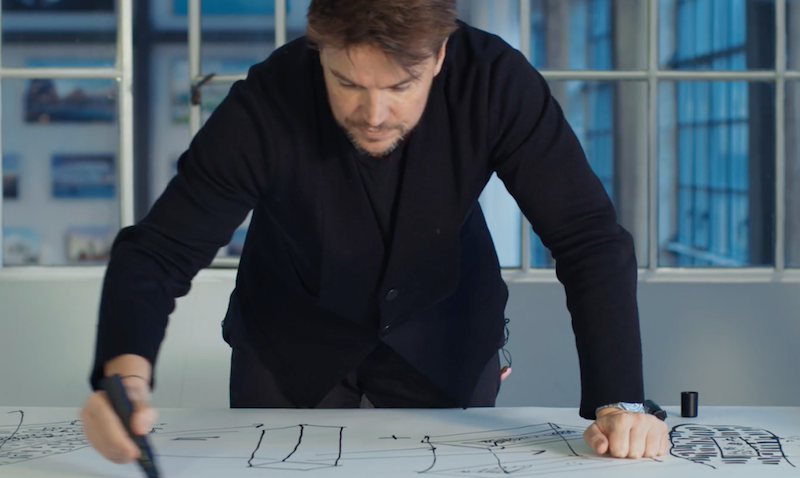Not long after Bjarke Ingels was the focus of an episode of the Netflix design series Abstract: The Art of Design, architecture’s golden child will once again find himself at the center of another documentary, this one titled Big Time.
The recently released trailer for the movie starts as you might expect, lighthearted and bright with a healthy smattering of inspiring quotes tailor-made for bedroom-wall posters, but the tone quickly changes.
“I got a concussion,” Ingels says, “and since then, I’ve had more or less of a constant headache.” The remaining half of the trailer takes on a more hectic, stressful, and dramatic tone; images of Ingels exhaustedly-staring off into the distance, climbing into an MRI machine, and anxiously sitting in project meetings paint an image of the architect not often seen.
The trailer ends with a quote that sums up Ingels’ dedication and need for his work. “If this is where I suddenly become unable to contribute meaningfully, you almost could just lie down and wait for everything to be over,” he says.
The documentary is an official selection of the Copenhagen Architecture Festival and will screen during the festival on May 3rd.
You can view the trailer below.
Related Stories
Building Team | Feb 24, 2015
Call for entries: 2015 Giants 300 survey
The annual Giants 300 Report ranks the top AEC firms in commercial construction, by revenue.
Industrial Facilities | Feb 24, 2015
Starchitecture meets agriculture: OMA unveils design for Kentucky community farming facility
The $460 million Food Port project will define a new model for the relationship between consumer and producer.
University Buildings | Feb 23, 2015
Future-proofing educational institutions: 5 trends to consider
In response to rapidly changing conditions in K-12 and higher education, institutions and school districts should consider these five trends to ensure a productive, educated future.
Office Buildings | Feb 23, 2015
The importance of quiet and the consequences of distraction
Recent work style studies show that the average knowledge worker spends 25-35% of their time doing heads-down focused work. Once thrown off track, it can take some 23 minutes for a worker to return to the original task.
Modular Building | Feb 23, 2015
Edge construction: The future of modular
Can innovative project delivery methods, namely modular construction, bring down costs and offer a solution for housing in urban markets? FXFOWLE’s David Wallance discusses the possibilities for modular.
| Feb 23, 2015
6 trends changing the way city dwellers live
Across the cultural grid, from food to retail to transportation, America's urban areas are already undergoing a major metamorphosis. Here are the six major trends shaping our cities, from Fast Company.
Green | Feb 23, 2015
State of the green union, and the next big shift in sustainability
The history of the green movement offers cues that we are on the precipice of another significant shift in the green union.
| Feb 23, 2015
Where are the iconic green buildings?
What does a green building look like? How would you know one if you saw one? Maybe a trivial question to some, but of great interest to architects, designers, and other members of the Building Team as the rapid evolution of sustainable buildings continues apace.
Sports and Recreational Facilities | Feb 21, 2015
Pumped-up recreation centers help build body, mind, and spirit
Adopting facility layouts from Asian and European models, today’s sports and recreational buildings are becoming social hubs that accommodate a variety of community needs.
University Buildings | Feb 20, 2015
Penn strengthens campus security by reviving its surrounding neighborhood
In 1996, the University of Pennsylvania’s sprawling campus in Philadelphia was in the grip of an unprecedented crime wave. But instead of walling themselves off from their surrounding neighborhoods, the school decided to support the community.















